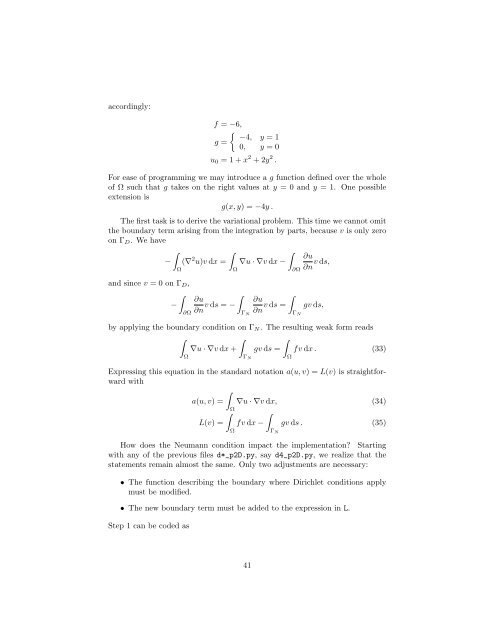A FEniCS Tutorial - FEniCS Project
A FEniCS Tutorial - FEniCS Project
A FEniCS Tutorial - FEniCS Project
Create successful ePaper yourself
Turn your PDF publications into a flip-book with our unique Google optimized e-Paper software.
accordingly:<br />
f = −6,<br />
{ −4, y = 1<br />
g =<br />
0, y = 0<br />
u 0 = 1+x 2 +2y 2 .<br />
For ease of programming we may introduce a g function defined over the whole<br />
of Ω such that g takes on the right values at y = 0 and y = 1. One possible<br />
extension is<br />
g(x,y) = −4y.<br />
The first task is to derive the variational problem. This time we cannot omit<br />
the boundary term arising from the integration by parts, because v is only zero<br />
on Γ D . We have<br />
∫ ∫ ∫<br />
− (∇ 2 ∂u<br />
u)vdx = ∇u·∇vdx−<br />
Ω Ω ∂Ω ∂n vds,<br />
and since v = 0 on Γ D ,<br />
∫<br />
−<br />
∂Ω<br />
∫<br />
∂u<br />
∂n vds = −<br />
Γ N<br />
∂u<br />
∂n vds = ∫<br />
Γ N<br />
gvds,<br />
by applying the boundary condition on Γ N . The resulting weak form reads<br />
∫ ∫ ∫<br />
∇u·∇vdx+ gvds = fvdx. (33)<br />
Ω Γ N<br />
Expressing this equation in the standard notation a(u,v) = L(v) is straightforward<br />
with<br />
∫<br />
a(u,v) = ∇u·∇vdx, (34)<br />
Ω<br />
∫ ∫<br />
L(v) = fvdx− gvds. (35)<br />
Γ N<br />
Ω<br />
How does the Neumann condition impact the implementation? Starting<br />
with any of the previous files d*_p2D.py, say d4_p2D.py, we realize that the<br />
statements remain almost the same. Only two adjustments are necessary:<br />
• The function describing the boundary where Dirichlet conditions apply<br />
must be modified.<br />
• The new boundary term must be added to the expression in L.<br />
Step 1 can be coded as<br />
Ω<br />
41

















